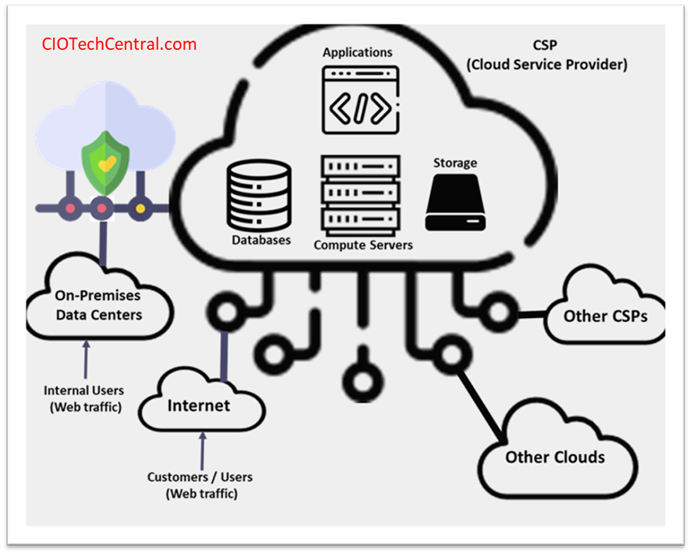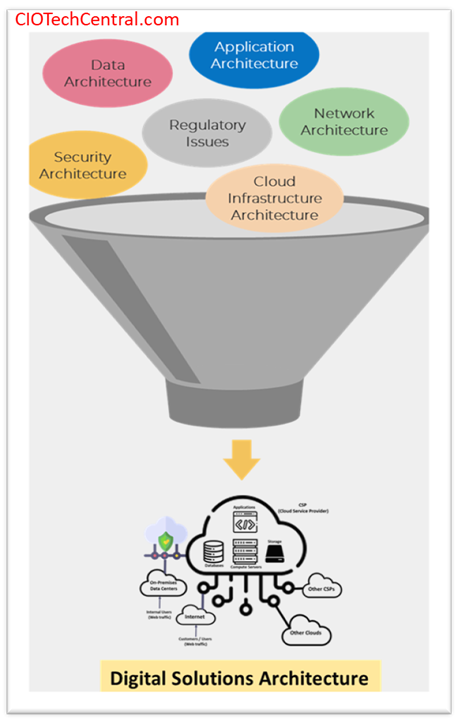Click here to get a Course on Cloud Solutions Architecture
Cloud Solutions Architecture is one of the most sought-out skills in the area of Digital and Information Technology industries. This is not surprising considering the mega rush toward digitalization and that almost all organizations are modernizing their systems to enable them to compete in digitally connected societies. As is very well recognized by all, no organization can afford to be left behind in becoming digitalized.
Considering that solutions architecture has become a very popular choice amongst a lot of technology professionals, this article sheds some light on the term “solutions architecture” and how can one become a solutions architect.
To help with that goal, I will first cover a basic understanding of the term “solutions architecture” and its relevance to cloud-based computing. We will then use that knowledge to help assess the skills that cloud and tech professionals need to become solutions architects. (For those who need to learn more about the fundamentals of Cloud Solutions Architecture, one is available here.)
What is a Solutions Architecture?
A Solutions Architecture of any system usually shows how the system is meant to work from a technical perspective. So, at a high-level, the solutions architecture shows all the technical elements and building blocks of the system being designed and implemented. This includes applications, databases, network elements, data flows, system interfaces, and other components that make up the overall technical solution. As a solution to a complex problem may involve numerous elements and their related interfaces, a solutions architecture depicts an orderly representation of various underlying technical components that can be used to understand the behavior of the overall system.

Beyond a high-level representation of the system, a solutions architecture also shows the details of the interfaces between the various technical elements and building blocks of the system being designed and implemented. For example, in the case of an e-commerce application, the solutions architecture of the system will show all the backend interfaces to the ERP systems and also any interfaces to the supplier and vendor systems.
The solutions architecture process also ensures the identification of all technical as well as non-technical dependencies within the overall system required to formulate the final solution. The resolution of these dependencies is crucial to ensure that the system being designed is deployed successfully to production and becomes operational.
Other key components of a solutions architecture include covering the overall behavior of the system, the various technologies that will be used in the system, and other details that show the overall structure and behavior of the system.
Sub-Architectures
The Solutions architecture discipline also covers multiple technical and non-technical architectural dimensions that are relevant to the complete functioning of the system. These dimensions are covered in varying levels of depth and detail in other architectural representations of the system. Examples of these include the following:
- Application Architecture
- Network Architecture
- Database Architecture
- Security Architecture
- Infrastructure architecture
- Design of User Experience
- Costs and Budgets
- Regulatory requirements (FedRAMP, G-Cloud, Business Related compliance such as HIPPAA, etc.)
- Others
We should note here that not all systems develop these detailed architectures and may instead rely on one reference architecture that’s being developed for the solution at hand. The related decisions in this context are taken by the senior technical management team, which includes the senior solutions architecture assigned to the project as well. Also, a majority of these sub-architectures are usually developed at an enterprise level and feed into the formulation of the project’s solution architecture. The figure below illustrates how various organizational architectures feed into the overall process of the creation of a project’s solution architecture.

Typical Responsibilities of Solution Architects
Next, let’s review the typical responsibilities of a solutions architect. These would help in further understanding what’s needed to become a solutions architect.
Without getting into a lot of details, solutions architects:
- Act as a liaison between Business and Technology teams
- Envision, design, and build the overall architecture of technical solutions
- Define the Solutions architect methodology and approach
- Evaluate digital technologies and tools to be used in the project
- Define the Solutions architect methodology and approach
- Evaluate digital technologies and tools to be used in the project
- Identify project interfaces and the overall integration architecture
- Identify all technology components of the overall system
- Develop the needed reference architectures for the organization
Typical Deliverables of a Solutions Architect
While working on the above activities, solutions architects create a number of key deliverables. While the solutions architecture deliverables vary from one organization to the next and also depends on the project, some typical solutions architecture deliverables include the following:
- Process Flow Diagrams (Show the activities of the business processes and the systems and the data that is used in those processes.)
- System Architecture Diagrams (Show all the components of the system and how they interface with each other and with other external systems.)
- Reference Architectures and Best Practices (A general-purpose architecture for specific types of projects, which can be used as a general blueprint for similar projects.)
- Various Descriptive Documents (Various descriptive documents that describe the various parts of the system along with documenting risks, assumptions, and so on.)
- Etc.
Examples of Cloud and Digital Systems and Solutions
Next, it would be prudent to get an idea on the types of technologies and projects that solutions architects usually work on. This, too, will help in understanding the potential career path that one may want to take to further your objectives as a solutions architect.
- Modernization of legacy applications cloud platforms.
- Solutions to help in factory automation, which are based on digital technologies such as IoT, 5G, Robotics, etc.
- Smart city solutions and infrastructure, which rely on IoT technologies such as connected sensors, lights, and meters. For data collection and analysis AI and other analytical technologies are used.
- Sophisticated Analytics and big data solutions used along with AI and ML technologies to help enhance business decision-making and insights.
- E-commerce applications serving multiple regions for global customers.
- Etc.
Core Skills Required to Become a Solutions Architect
Based on the above, we can now summarize some of the key skills that are required for one to become a cloud solutions architecture. The following reviews some of the skills that a Solutions Architect usually requires to be successful in their role. Here, we should note that the required skills that a solutions architect needs to have can vary considerably depending on how an organization defines the role of a solutions architect. For example, some organizations define the role to be specialist in certain technologies, while others don’t require their solution architects to be very technical and specialists. Also, some roles may require solution architects to function at a rather higher level in an oversight capacity, while others may require their solutions architects to be quite hands-on.
System Architecture / Architectural Principles
This refers to possessing a thorough understanding of the solutions architecture domain in general and the various architectural principles that underpin the architecture of any digital system. The architectural principles refer to system attributes such as application and network performance, security, application scalability, user experience, reliability, business continuity, determining workload capacity, and other similar aspects in the overall architecture and design of the system. These principles are required regardless of whether one is building and integrating an Analytics type of a system or whether it’s a 5G-based network that builds on cloud technologies.
Cloud and Virtualization Technologies
These skills refer to the understanding of cloud and virtualization technologies and related skills. These include having an understanding of the architecture of the public cloud, how they integrate with on-premises systems, the various technologies related to the deployment and running of cloud-based systems, and so on.
Technology-specific skills
These skills refer to the specific technologies being used on the project. For example, if we look at a typical digital project based on cloud technologies, it could make use of a number of technologies such as AI/ML, IoT, 5G, and so on. Other organizations and roles may require more specific knowledge of those technologies in specific environments such as AWS, Azure, Google Cloud Platform, etc. In this context, some common focus areas / digital technologies include the following:
- Cloud migration
- Cloud native application development
- AI / ML applications
- Data analytics and Big Data
- 5G enabled networking cloud
- IoT and Robotics
- Etc.
Business Analysis Skills
As one of the key responsibilities of solutions architects is to work closely with the business community, it’s important that they also possess good business analysis skills, which would help them in actively participating in discussions with the business users to discuss the architecture and design of the desired system.
Project management skills
As solutions architects have a broad responsibility to work on the project, they should have strong project management skills along with organizational change management skills as well. These skills can help them manage the project effectively and ensure that the changes introduced by their project can be introduced smoothly into the organization.
Soft Skills
Due to the multi-dimensional role of a solutions architect, solutions architects should also have a number of soft skills. Some of the critical ones include the following:
- Stakeholder engagement
- Senior Leadership Engagement
- Verbal and Written Communications Skills
- Facilitation Skills
- Leadership skills
- Presentation Skills
Conclusion
This article attempted to provide a high-level understanding of the “Solutions architecture” discipline and the skills that one may need to become a solutions architect. If you are looking for additional information, please join my list where you can obtain a lot of rich content related to Solutions architecture and can stay updated on latest news related to Solutions architecture-related skills and career development. Join the List Below.


